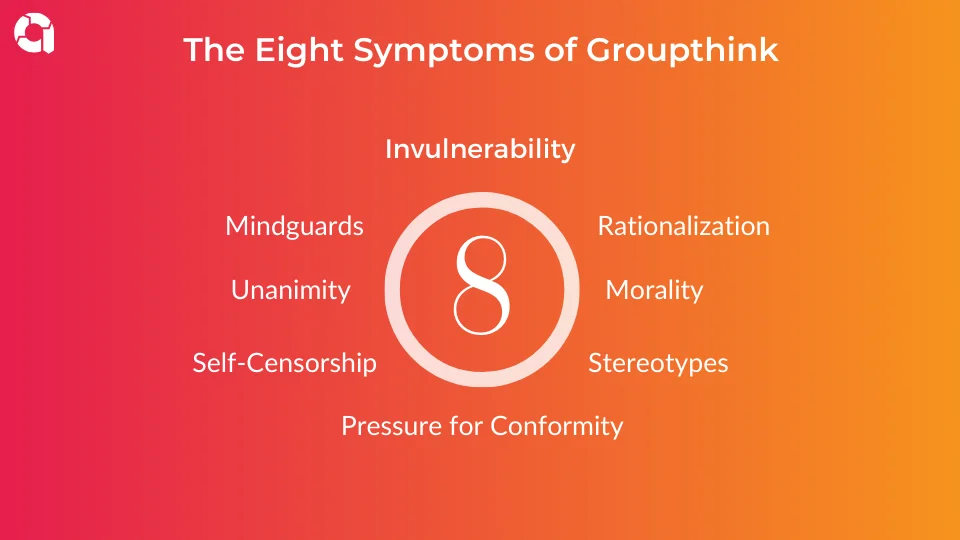Groupthink is a term that was coined by social psychologist Irving Janis in 1972, and it describes the phenomenon that occurs when individuals within the same group, such as a workplace team or school club, put their desire to maintain unity and reduce conflicts ahead of other considerations. Janis originally defined groupthink as “A mode of thinking that people engage in when they are deeply involved in a cohesive in-group, when the members’ strivings for unanimity override their motivation to realistically appraise alternative courses of action.” (I. Janis,1991)
Groupthink is often identified by an inability to explore alternative options, irrational behavior, poor decision-making, acting without considering facts and evidence, or resisting criticism. While it can be hard for an outsider to spot the signs of groupthink in action , understanding how to recognize these behaviors is key for preventing them from taking hold.
This article aims to provide you with a comprehensive understanding of groupthink, including its eight characteristics, common signs, manifestation, and consequences. By equipping you with this knowledge, we hope to help you detect and counter the negative effects of groupthink, as well as develop strategies to prevent it.
Signs of Groupthink: Recognizing the Symptoms
What are the signs that a group’s loyalty has led them to fall into groupthink? Janis listed eight symptoms to indicate when a group’s desire for harmony has caused them to go off track. As individuals prioritize consensus over critical evaluation of ideas, several tell-tale symptoms may emerge. While the concept of groupthink may seem complex, it is important to recognize these signs in order to foster healthier group dynamics and avoid potential pitfalls. By staying informed and vigilant, we can create an environment that encourages open dialogue and well-rounded decision-making.

The eight symptoms of groupthink as shown in figure 1 are: (I. L. Janis 1982)
1.Invulnerability:
Invulnerability, shared by most or all the members, creates excessive optimism and encourages taking extreme risks. It can emerge within groups, leading to a false sense of security and overconfidence. This concept refers to the dangerous belief that one’s group is immune to failure or negative consequences, causing them to overlook potential risks and engage in reckless decision-making. Group dynamics that promote conformity and discourage dissent may contribute to the illusion of invulnerability, as individuals feel protected by the collective strength of the group. The study of this intriguing concept serves as an important reminder for us to remain vigilant against overconfidence and always consider the potential consequences of our actions, both individually and collectively.
2.Rationalization:
In the midst of decision-making, it can be easy to rely on past policies and assumptions without giving them a second thought. However, it’s crucial to remember the importance of rationalizing and re-evaluating these beliefs before committing to them once again. Unfortunately, many groups fall into the trap of discounting warnings that may challenge their past decisions in an effort to maintain a sense of consistency. This can be dangerous, as it leads to a groupthink mentality that fails to consider all options and makes it difficult to confront potential roadblocks. By encouraging collective efforts to systematically review assumptions and policies, organizations can create an environment that supports critical thinking and effective decision-making. So, the next time you encounter a warning that calls your assumptions into question, embrace it as an opportunity to reassess and rationalize your beliefs.
3.Morality:
When people come together to form a group, it is natural to want to believe that the group is inherently moral. After all, we tend to gravitate towards those who share our values and beliefs. However, this unwavering trust in the group’s morality can lead members to ignore the ethical consequences of their decisions. They become so convinced of their righteousness that they fail to consider how their actions might affect others. In some cases, this can lead to serious harm, whether it be to individuals or society as a whole. As such, it is important for groups to remain mindful of their actions and their impact on those around them. Blindly following a belief in inherent morality can be detrimental in the end.
4.Stereotypes:
When faced with outside rivals, the group often creates negative stereotypes and develops simplistic views of enemy leaders. These views can be extreme, either seeing them as too evil to negotiate with or too weak to handle risky attempts. Throughout history, enemy leaders have been subject to stereotyped views that make negotiations and interactions difficult. Many times, they are seen as too evil to warrant genuine attempts to negotiate, or as too weak and stupid to counter whatever risk attempts are made to defeat their purposes. This can hinder peaceful resolutions and even escalate conflicts. It’s important to remember that leaders are not defined by simple stereotypes, but by their actions and beliefs. Only through genuine communication and understanding can fruitful negotiations take place. While it may be tempting to rely on these stereotypes, it’s vital to approach each situation with an open mind and willingness to listen in order to move towards peaceful resolutions.
5.Pressure for conformity:
In any group or social setting, there is always a certain level of pressure for conformity. This pressure can come from a variety of sources, including peer pressure and societal norms. In any group, it is important to have open discussions and healthy debates to ensure that everyone is on the same page. However, when direct pressure is placed on members who express strong arguments against stereotypes, illusions or commitments, it stifles growth and progress. This type of dissent should be openly welcomed and encouraged, as disagreement and constructive criticism often lead to improved ideas and strategies. Loyal members should not be afraid to express their opinions, as this is crucial for the success and development of any group. It is important to remember that questioning and challenging the status quo should be viewed as a positive rather than a negative.
6.Self-censorship:
The concept of self-censorship in-group settings is a fascinating one to explore. It’s no secret that humans have an innate desire to belong and be accepted by their peers. However, when it comes to voicing dissenting opinions or sharing doubts about the group consensus, that desire for acceptance can lead to self-censorship. This can manifest as individuals minimizing the importance of their doubts and counterarguments, which can ultimately hinder the group’s ability to make well-informed decisions. The fear of being ostracized or labelled as a troublemaker can be a powerful force, but it is important to remember that healthy discourse and dissent can lead to growth and progress. Self-censorship may seem like an easy option, but it is worth challenging ourselves to speak up and be fearless in our pursuit of truth.
7.Unanimity:
The concept of a shared illusion of unanimity may seem esoteric, but it’s a phenomenon that occurs more frequently than many of us are aware of. Essentially, it refers to the tendency for individuals to conform to the majority view, even when they may not fully agree with it. This can be partly caused by self-censorship, as people may not feel comfortable expressing dissenting opinions. Additionally, there is often a false assumption that silence implies consent, which can further reinforce the illusion of unanimity. While this phenomenon may be concerning, it’s important to recognize it so that we can work to foster a greater diversity of thought and encourage individuals to speak up when they have differing views.
8.Mindguards:
It is not uncommon for groups to encounter information that challenges their beliefs and opinions. In such situations, it is up to the members to decide whether they would like to address the adverse information head-on or try to ignore it. However, what happens when some members decide to appoint themselves as guardians of the group’s beliefs, assuring that no information that may threaten their shared complacency is allowed in? These self-appointed mindguards can become a powerful force that keeps a group stagnant and closed-minded. While their intentions might seem noble, their actions can ultimately hinder the group’s growth and progress. It’s important to remember that being open to challenging information can help a group learn and adapt, leading to better decision-making and a more dynamic overall experience.

Unlock Potential Today
Elevate your professional value with Systems Thinking certifications.
Groupthink can be a detrimental force that sneaks up on even the most collaborative teams. When a group displays symptoms of groupthink, it can result in unintended consequences and impede progress. In order to avoid groupthink, it is crucial to identify and confront these indicators by creating an environment that encourages open communication, constructive disagreement, and psychological safety. By doing so, groups can reach their full potential and drive success in today’s fast-paced and constantly changing world.
Conclusion
Who could have possibly imagined that a theory created back in 1970s had such an impact on our current society and how it warns us of possible future problems? Janis’ concept of groupthink has been used to help guide us past decision-making pitfalls for almost 50 years. However, we must remain vigilant in order to prevent the occurrence of groupthink among many different social and professional groups, as its presence can be detrimental. It is also important that individuals are aware of what groupthink looks like and take measures to ensure their own unique opinion is broadcast within the group. We can all use Janis’ concept as a useful tool throughout our lives when working towards collective decisions. By maintaining detailed awareness and being mindful regarding how and why our thoughts come about, we can evaluate situations with more clarity and on an individual basis rather than simply following the majority mindset.


